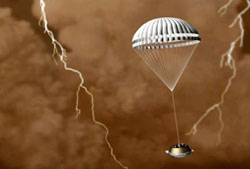First measurement of Titan’s winds from Huygens

Huygens probe descending through Titan’s atmosphere
Using a global network of radio telescopes, scientists have measured the speed of the winds faced by Huygens during its descent through the atmosphere of Titan.
This measurement could not be done from space because of a configuration problem with one of Cassini’s receivers. The winds are weak near the surface and increase slowly with altitude up to about 60 km, becoming much rougher higher up where significant vertical wind shear may be present.
Preliminary estimates of the wind variations with altitude on Titan have been obtained from measurements of the frequency of radio signals from Huygens, recorded during the probe’s descent on 14 January 2005. These ‘Doppler’ measurements, obtained by a global network of radio telescopes, reflect the relative speed between the transmitter on Huygens and the receiver on the Earth.
Winds in the atmosphere affected the horizontal speed of the probe’s descent and produced a change in the frequency of the signal received on Earth. This phenomenon is similar to the commonly heard change in pitch of a siren on a speeding police car.
Leading the list of large radio antennas involved in the programme were the NRAO Robert C. Byrd Green Bank Telescope (GBT) in West Virginia, USA, and the CSIRO Parkes Radio Telescope in Australia. Special instrumentation designed for detection of weak signals was used to measure the ‘carrier’ frequency of the Huygens radio signal during this unique opportunity.
The initial detection, made with the ‘Radio Science Receivers’ on loan from NASA’s Deep Space Network, provided the first unequivocal proof that Huygens had survived the entry phase and had begun its radio relay transmission to Cassini.
The very successful signal detection on Earth provided a surprising turnabout for the Cassini-Huygens Doppler Wind Experiment (DWE), whose data could not be recorded on the Cassini spacecraft due to a commanding error needed to properly configure the receiver. “Our team has now taken a significant first step to recovering the data needed to fulfil our original scientific goal, an accurate profile of Titan’s winds along the descent trajectory of Huygens,” said DWE’s Principal Investigator Dr Michael Bird (University of Bonn, Germany).
The ground-based Doppler measurements were carried out and processed jointly by scientists from the NASA Jet Propulsion Laboratory (JPL, USA) and the Joint Institute for VLBI in Europe (JIVE, The Netherlands) working within the DWE team.
Winds on Titan are found to be flowing in the direction of Titan’s rotation (from west to east) at nearly all altitudes. The maximum speed of roughly 120 metres per second (430 km/h) was measured about ten minutes after the start of the descent, at an altitude of about 120 km. The winds are weak near the surface and increase slowly with altitude up to about 60 km.
This pattern does not continue at altitudes above 60 km, where large variations in the Doppler measurements are observed. Scientists believe that these variations may arise from significant vertical wind shear. That Huygens had a rough ride in this region was already known from the science and engineering data recorded on board Huygens. “Major mission events, such as the parachute exchange about 15 minutes into the atmospheric flight and impact on Titan at 13:45 CET, produced Doppler signatures that we can clearly identify in the data,” Bird said.
At present, there exists an approximately 20-minute interval with no data between the measurements at GBT and Parkes. This gap in Doppler coverage will eventually be closed by data from other radio telescopes which are presently being analysed. In addition, the entire global set of radio telescopes performed Very Long Baseline Interferometry (VLBI) recordings of the Huygens signal to determine the probe’s precise position during the descent.
“This is a stupendous example of the effectiveness of truly global scientific co-operation,” said Jean-Pierre Lebreton, ESA Huygens Project Scientist. “By combining the Doppler and VLBI data we will eventually obtain an extremely accurate three-dimensional record of the motion of Huygens during its mission at Titan,” he concluded.
Media Contact
All latest news from the category: Physics and Astronomy
This area deals with the fundamental laws and building blocks of nature and how they interact, the properties and the behavior of matter, and research into space and time and their structures.
innovations-report provides in-depth reports and articles on subjects such as astrophysics, laser technologies, nuclear, quantum, particle and solid-state physics, nanotechnologies, planetary research and findings (Mars, Venus) and developments related to the Hubble Telescope.
Newest articles

Silicon Carbide Innovation Alliance to drive industrial-scale semiconductor work
Known for its ability to withstand extreme environments and high voltages, silicon carbide (SiC) is a semiconducting material made up of silicon and carbon atoms arranged into crystals that is…

New SPECT/CT technique shows impressive biomarker identification
…offers increased access for prostate cancer patients. A novel SPECT/CT acquisition method can accurately detect radiopharmaceutical biodistribution in a convenient manner for prostate cancer patients, opening the door for more…

How 3D printers can give robots a soft touch
Soft skin coverings and touch sensors have emerged as a promising feature for robots that are both safer and more intuitive for human interaction, but they are expensive and difficult…





















